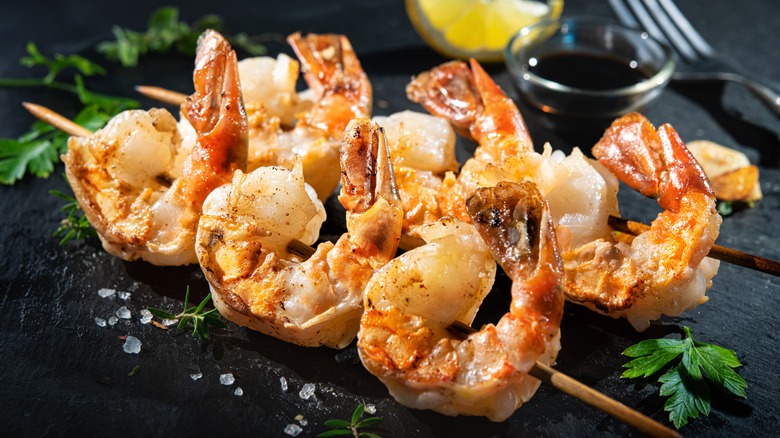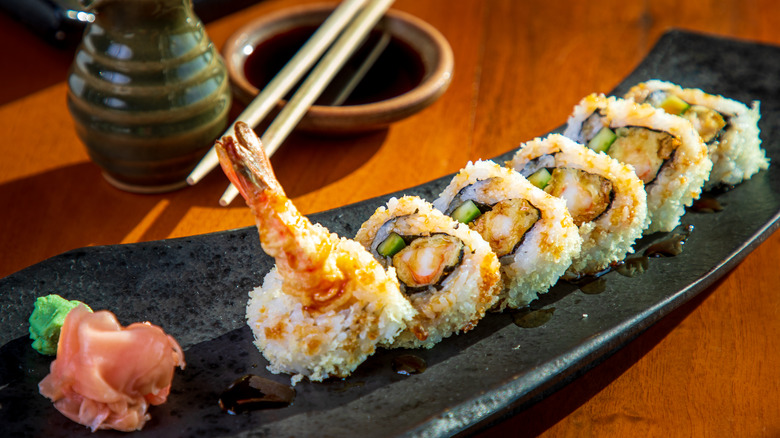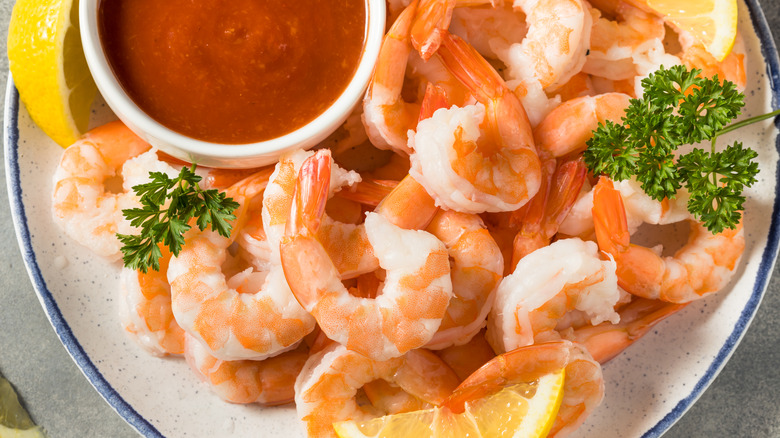Finally Know If It's Actually Safe To Crunch Down On Shrimp Tails
Shrimp is always a tasty option, whether at a beachside lunch or for a dinnertime shrimp cocktail. While dining on the flesh is a treat, consuming the tails is avant-garde, like observing a Salvador Dalí painting for the first time. It doesn't necessarily feel wrong, but it doesn't seem right either. What's the purpose or end goal? Awe, wonder, dread, and curiosity follow as those pink-tinted encasings with scarlet ends are guzzled down. However, these emotions do not go totally unfounded in Western societies. We once believed that shrimp tails were inedible and harmful to the human body — but that may not actually be true.
There is a science tied to the eating of shrimp tails. These fibrous shells are made of chitin and chitosan, protective materials found in other species that contain a hardened exterior layer. Chitin does not dissolve or break down easily, primarily because it is used as an organism's defense mechanism. It's why we discard crab and lobster shells rather than attempt to choke them down. Chitosan, on the other hand, is far more soluble. Some studies have found that certain acidic elements in our digestive tract can effectively break this stubborn component apart. So, if you've ever found yourself curious: Yes, shrimp tails are safe to eat. They also benefit us by effectively holding the shape of the shrimp as it cooks. The shell allows the meat inside to soak up additional flavors and moisture. In fact, removing them prematurely can cause the shrimp to taste bland or appear less than half its original size. So, let's dive into all things eating shrimp tails.
Why you might want to eat shrimp tails
Shrimp tails and salmon skin are a lot alike. You can eat them, but do you really want to? Some recipes require the skin and shells to be completely removed, while others openly welcome their savory crisp. A classic example of this is in sushi. Whenever you're hit with an elongated stone plate with a shrimp tempura roll, there will most likely be a few picturesque pieces with tails poking out at the end. The shrimp inside is satisfying as-is, but engorging on the tails is an experience in itself. Shrimp tails, after properly prepped and cooked, are an appetizing element with an amazing texture and flavor. They also contain some of the best naturally-found fibers that help foster an influx of prebiotics in humans.
Chitin and chitosan effectively reduce high cholesterol levels and manage obesity rates. Between immunity elevation and the overall weight and health benefits provided by these crispy delights, it's a no-brainer we should incorporate them into Western diets more. Chinese cuisine celebrates whole battered and fried shrimp, including the head, shell, and tail. Not only does it enhance the presentation of a carefully curated meal, but it also keeps the flavors in tact. And while you don't have to eat the head, it does have an insanely tasty and creamy element: the brain. But if you want to focus more on nutrients than taste (or don't enjoy eyes), you might want to stick with just the tails.
Does this extend to shrimp cocktail or poached shrimp?
This leaves us with the question of ingesting poached or simmered shrimp tails: Is it harmful or just not tasty? Poached shrimp tails are very dissimilar to those deep fried in tempura batter. Instead of an unexpectedly delicious feature, these tails become almost rubbery and difficult to chew. In the sushi subreddit, one user reported that eating tails that have not been battered or fried can become a bit of a fight than a feast. "Since sweet shrimp is served raw, the tail is au naturale (not crispy as when fried) and is pretty tough," they commented. "I would assume you would [remove the tail] since the shrimp nigiri (ebi sushi) is usually cooked (poached), and not deliciously crunchy from the tempura fryer. That being said, if you like it, eat it."
Still, deep-frying shrimp tails in tempura batter isn't the only way to enjoy them. If you have some tails and shells left over, they can be boiled and turned into a perfectly good broth. This is an excellent and easy way to gain a savory stock for jambalaya or gumbo, while simultaneously reducing food waste. Before making the stock, however, it's important to remove the vein at the bottom of the shrimp. The discolored grime inside the digestive tract can make the shrimp unappetizing and unappealing.


